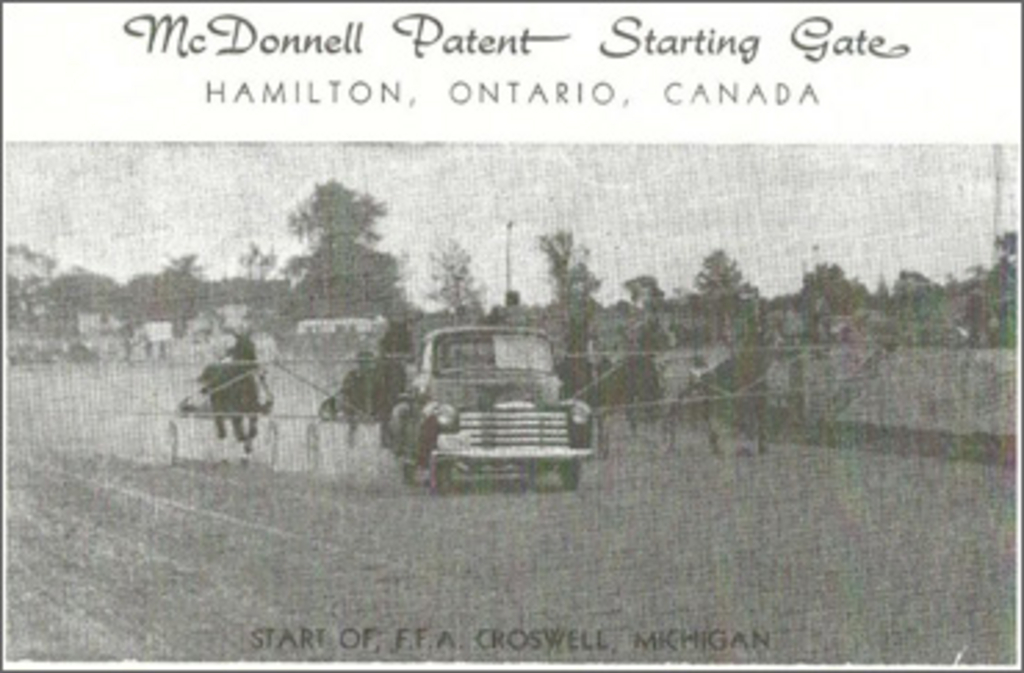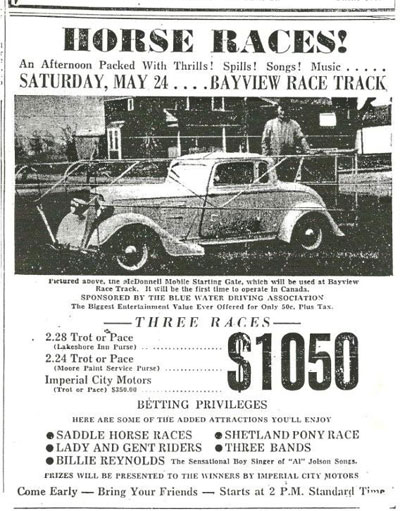SC Rewind: Canada’s First Starting Gate

In this week's Rewind Robert Smith describes the very first starting gate to appear in Canada and a little about its creator and operator Thomas McDonnell
. This is the first edition of a two part story.
When the 1947 racing season began something was different, very different, in fact the sport was about to undergo its biggest change since the coming of the low wheeled sulky some 50 years earlier. You might say "The winds of change were blowing." And another old cliché states that "with change comes opportunity.”
One of the real detrimental aspects of the sport of harness racing's early years involved the starting of races. The system of open scoring was tedious, ineffective and appealed to virtually no one. It was a "bugaboo" that had held the sport back and was said to drive fans away in droves as well as ruining many fine horses. A solution had to be found.
In May of 1946 the introduction of the mobile starting gate in the U.S. had been met with immediate acceptance by one and all. Its inventor and first operator was a man named Steve Phillips of Xenia, Ohio. What would it take to bring this revolutionary idea to Canada? Here is where the "opportunity" met with an entrepreneur. An enterprising gentleman by the name of Thomas McDonnell was eager to give it a try. He had all of the energy and enthusiasm to meet the challenge. Armed with only a magazine photograph of the new contraption he set about the task.
Born and raised in Hamilton, Mr. McDonnell was around 40 years of age at the time and a full time employee of Dofasco, the area's largest employer. He was neither an engineer, a designer or even a tradesman, but that would not deter him. A horseman from birth and with several years experience as a licensed starter in the current system, he possessed a unique perspective. Above all he knew if the sport was to survive and thrive, something had to be done. In the fall of 1946 the tedious task of building this first gate began. Using a small garage and assisted by a colleague named Fred Metcalfe who was a welder and a mechanic, the "bones" of the starting gate he envisioned began to take shape. Trial runs took place at a nearby school yard as well as frequent trips to the McDonnell family track. Seven months later and after much "tweaking", the finished product was ready to go.
 Simple in design, the gate was mounted on the family car, a 1939 Plymouth coupe. The trunk lid was removed and with the assistance of two helpers, the gate wings were mounted and ready for action. The closing device was taken from the steering mechanism from a large truck. Mounting time was about one half hour. The "audio" system was pretty basic, a tap on the back window meant "speed it up". An ad was run offering the new service and the first reply to try the new gate came from the Bluewater Driving Association at Sarnia's Bayview Racetrack. Their meeting was traditionally the first of the season which at that time was the May 24th holiday weekend. What better time than now; it would be a big day in a small town. A Sarnia newspaper ad described it as "The Biggest Entertainment Value ever offered for 50 cents! " There would also be saddle horse races, several bands and a singer who impersonated Al Jolson and more.
Simple in design, the gate was mounted on the family car, a 1939 Plymouth coupe. The trunk lid was removed and with the assistance of two helpers, the gate wings were mounted and ready for action. The closing device was taken from the steering mechanism from a large truck. Mounting time was about one half hour. The "audio" system was pretty basic, a tap on the back window meant "speed it up". An ad was run offering the new service and the first reply to try the new gate came from the Bluewater Driving Association at Sarnia's Bayview Racetrack. Their meeting was traditionally the first of the season which at that time was the May 24th holiday weekend. What better time than now; it would be a big day in a small town. A Sarnia newspaper ad described it as "The Biggest Entertainment Value ever offered for 50 cents! " There would also be saddle horse races, several bands and a singer who impersonated Al Jolson and more.
To ensure that their arrival for the 2 p.m. post time could be met without difficulty, Mr. McDonnell and his two passengers left Hamilton the day before. Arrangements had been made for an overnight stay at a Sarnia Hotel near the track. Along with Tom was his then 11-year-old son Bill, and his driver Jim MacDonald, a local horseman. Young William recently recalled the thrill of staying at a hotel for the first time and the sight of the large rope near the window. For those who have never stayed in an old-time hotel, that was the fire escape.
The afternoon's racing program consisted of three races, each of 3 heats. The total purse money offered was $1,050, with equal amounts of $350 for each event. The winner of the featured Free For All Pace was Lorne Lee, a highly successful horse of that era owned, trained and driven by Alfred J. Moore of Sarnia. The only three-heat winner was a horse with a nice simple name, Black Joe from the stable of Jack Morrissey of Crediton, Ont., who also had a win with Super Volo. Another two-heat winner was a mare of note, Kitty Bars a daughter of the great Grattan Bars owned by Fred Thrower of Strathroy.
Prior to this day it would be safe to say that virtually no one had ever seen a starting gate before unless by chance they had been to the U.S. or had perhaps made a visit to the McDonnell farm. The working of the gate went off without any problems and everyone was immediately in favour of the new and revolutionary way of starting. Along with the estimated 2,500 fans on hand that day, horsemen with names still familiar today were among the first to be "baptized". A number of other local enthusiasts were part of this historic day including Stan Dunham and Allan Elliott of nearby Pt. Edward, Nate Neely, Marshall Moore and Neil Pringle of Sarnia. There were obviously many more whose names have now been faded by the passing years.
Undoubtedly, as the McDonnell car wended its way back to Hamilton Mountain that evening, its driver had to have a pretty big smile on his face. A new era had just begun.
The second and concluding portion of this Rewind will be published next month.

